Current as of: January 19, 2026 - 07:18

Tajikistan Expedition: Pamir Highway & beyond Trip Notes
- Ways to Travel: Guided Group
- Destination: Tajikistan
- Programmes: Culture
-
Activity Level:
4 out of 7 - Moderate & Challenging
- 16 Days: Land Only
- Ages: 16+
- Trip Code: ATJ
- Carbon Footprint: 15.9kg CO2e
Trip Overview
Journey through the remote Pamir Mountains and along the Afghan border
The Pamir Highway: Central Asia’s greatest road adventure in Tajikistan. Travelling in 4x4s, we follow this rugged mountainous route through the remote Pamir range, discovering an area along the Afghan border, much of the time alongside the Panj River, that only the most adventurous ever explore. On the way, we visit the ruins of Zoroastrian castles and shrines and see a Buddhist stupa. We head off the main highway to go even deeper into the country, encountering lands where the language changes from one valley to the next. To make sure we see as much as possible, we’ve designed our tour to roughly follow a figure of eight, meaning we mostly avoid retracing our steps.
At a Glance
- Accommodation: 4 Classic nights (hotels), 11 Simple nights (homestays and guesthouses)
- Travel by 4×4 (maximum three passengers per vehicle) and minibus
- An adventurous trip through a spectacular and little-visited region
- Group normally 4 to 12, plus leader. Minimum age: 16
Highlights
- Drive along the spectacular Pamir Highway
- Enjoy views to the Hindu Kush and Karakorum mountains
- Peer across the Panj river into Afghanistan
- Trace the lines of the Wakhan Corridor, a region associated with the Great Game
- Visit archaeological sites and remnants of the Silk Road
- Search for Marco Polo sheep and markhor goats
- Take a day walk between remote villages in Bartang
Is This Trip for You?
This trip has been rated Activity Level 3 (Moderate). For more information on our trip gradings please visit the Activity Level Guidelines page. If you have any queries about the difficulty of the trip please do not hesitate to contact us.
We rated this trip Activity Level 4 (Moderate & Challenging) due to the long journeys and rugged, unpredictable nature of travel in this extremely remote region. Good health is important. There is some walking on this trip, though generally only short walks. The exception is on Day 12 when we walk 8.5mi (14km).
Drives: There are very long drives throughout this trip. The roads and tracks are often rough. If you suffer from travel sickness, this trip is not suitable for you. Please see the transport section for more detail.
Comfort: The Pamirs has very basic infrastructure and comfort levels are far lower than you would have at home. Eleven nights of the trip are in homestays and guesthouses. We accommodate guests in the best possible homestays and guesthouses, which are run by hospitable hosts. These usually have a shower and a Western-style toilet and you may sleep on the floor on traditional mats filled with cotton. Some homestays and guesthouses only have one or two toilets. Some don’t have a dining table, so guests are expected to sit cross-legged on the floor during meals. When using the shower and hot water, please be mindful and use just what you need. On most nights, you must share a room with more than one person; we make every effort to ensure men and women who are not travelling together don’t have to share a room, but this cannot be guaranteed. On these nights, single supplements do not apply. You are provided one set of bed linen at the start of the trip for the homestays. Please note, some places along the trip have squat toilets.
Altitude: This trip spends time above 9,842ft (3,000m); please refer to the Altitude Warning within the Trip Notes for more information and advice on how to limit the effects of altitude sickness.
- Maximum altitude: 13,484ft (4,110m)
- Maximum sleeping altitude: 13,484ft (4,110m)
Clothes: When visiting mosques and other religious buildings, women should wear long skirts and have their shoulders covered. We also advise bringing a scarf and covering your head on such occasions. Knee-length skirts/dresses, shorts and sleeveless tops are fine in other circumstances.
Itinerary changes: This trip is expeditionary in style. We aim to follow the itinerary as shown, but due to the remote nature of this trip, unpredictable road conditions, weather and other local conditions changes are always possible.
Water safety: This trip includes time by a lake, river or sea, where there may be opportunities to swim. You should always seek local advice before deciding whether to swim. Open-water or wild swim spots should be treated with extreme caution. Information on how to keep yourself safe while swimming is shown here.
Group
The group will generally be between four and 16 people.
Adult min age: 16
Min group size: 4
Max group size: 12
Itinerary
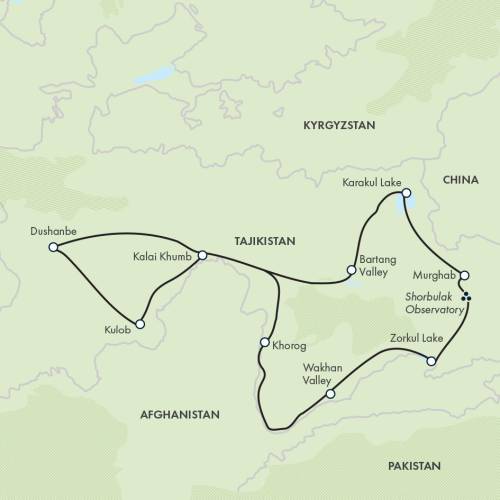
Land Only
- Start City: Dushanbe
- End City: Dushanbe
Land Only Itinerary
Arrive into Dushanbe today (or very early morning next day) and overnight.
Accommodation: Atlas Hotel (or similar)
Fly to Dushanbe, the capital of Tajikistan. Flights usually arrive in the early hours of the morning of the following day. We’ll be met at the airport and driven to the hotel.
Accommodation: Atlas Hotel (or similar)
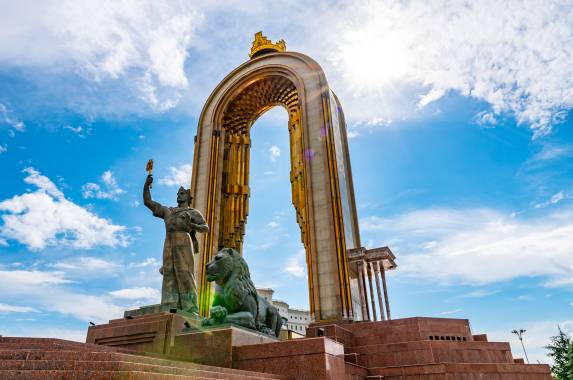
We leave the hotel around 10.30am and start exploring Dushanbe, the capital of Tajikistan. We start with an overview of Tajik history at the National Museum of Antiquities, where we see a reclining Buddha statue. Next, we visit Mehrgon Market where we can try local fruits and learn Tajik bargaining skills.
We have lunch (not included) in a cafe within a training centre run by the NGO Chatr, which means umbrella. The centre provides free courses to women who have suffered abuse.
Later in the afternoon, we walk beside the fountains of Rudaki Avenue and visit the Rudaki Monument, dedicated to the founder of Tajik-Persian literature. We also see the Ismail Somoni monument to the first emir of the Tajik nation. Next stop is the Gurminj Musuem of Pamiri Musical Instruments. We end the day with the choice of a cooking class or pottery demonstration. The cooking class sees us learn about plov, the rice and meat-based national dish.
Accommodation: Atlas Hotel (or similar)
We drive south from Dushanbe passing through hilly landscapes and pastures to reach Norak Dam. We continue to Hulbuk Fortress and museum in Vose to learn more about the regional history. Following a stop for lunch (not included) in the city of Kulob, we visit the mausoleum of Mir Said Ali Hamadani, a poet from Iran who preached Islam in Central Asia. Our drive continues over the Shurobod Pass to Anjirob, where we stay overnight with a local family.
We cover around 150mi (240km) today on good roads, which takes about six hours with stops, with a maximum altitude of 2890 ft/880m. Daytime temperatures can be very high today.
Accommodation: Homestay
Following a very early start, we drive to into the hills to view markhor goats, the largest member of the goat family, best known for their twisting horns. This animal-watching adventure can take about three hours including the driving. We do this very early while temperatures are cooler as chances of seeing the goats are better before the heat of the day sends them to shelter behind cool rocks. This can mean leaving our homestay at approximately 4 am (it is possible to remain at the homestay if you prefer). The goats are usually seen through binoculars or a telescope.
As we continue our journey, the road squeezes through the gorge of the Panj River into the western Pamirs. The Panj forms the border with Afghanistan, which we follow for the next few days, allowing us to peer into Afghanistan along the way.
On arrival in Kalai Khumb (altitude 1,270m), we walk in town or visit the Karon archaeological site, which is thought to be the last-surviving Zoroastrian water temple in Central Asia and has only been excavated relatively recently. There are fantastic mountain views from the site.
There are about three hours of driving today (75mi/120km) mostly on good roads, with a maximum altitude of 1,270m.
Accommodation: Guesthouse
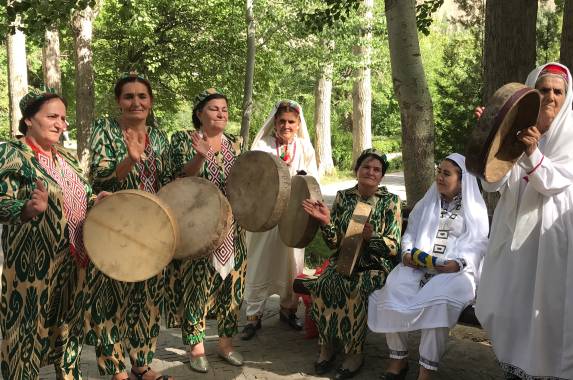
If we didn’t visit Karon yesterday, we do so this morning. We continue our drive along the Panj River, tracing the border, stopping for a box lunch along the way. Early afternoon, we reach Khorog, the capital of the mountainous Badakhshan region. At an altitude of around 6,800ft (2,100m), it sits in a narrow valley where the Shakhdara and Ghund rivers flow into the Panj. While small, the town is an important cultural centre with two universities and a theatre. We explore Khorog, walking through Chorbogh park.
We drive for around seven hours (160mi/260km) today including stops, mostly on a poor road which is undergoing construction work in places which can sometimes delay our journey. Maximum altitude of 6,840ft (2,085m).
Accommodation: Lal Inn (or similar)
This morning, we visit Khorog bazaar. Here, we can purchase traditional goods, including juraby (woollen socks) and toki (colourful embroidered skullcaps). We also visit Khorog botanical gardens, high above the city.
From Khorog, the Pamir Highway heads east. However, we’ll head south, continuing along the Panj River and the Afghan border. We stop at Garm Chashma, a small town home to sacred, sulphurous hot springs. Impressive white-yellow deposits are formed where the water flows out of the earth and cools. We continue to Ishkashim, where the valley widens and the waters of the Panj calm. This is the start of the Wakhan Valley, a legendary area in the Silk Road age. Always remaining in Tajikistan, we follow a route along the edge of the Wakhan Corridor, which once acted as a buffer between the Russian and British empires during the Great Game. This sliver of Afghanistan separates Tajikistan from Pakistan to the south. To the east lies the Xinjiang province of China.
The Wakhan is home to mountain fortresses and numerous other intriguing sites. To the north are the Pamirs, to the south are the mountains of the Hindu Kush and Karakoram.
We have a picnic lunch in Namadgut and visit Qah-Qaha fortress and Shohi Mardon shrine. We have views to Karl Marx Peak (22,057ft/6,723m) and Engels Peak (21,348ft/6,507m). In the evening, we reach Yamg and spend the night in a chid, a traditional Pamiri home. Following dinner, we have a demonstration of local Pamiri dances.
We drive for around six hours today (155mi/250km) including stops, with a maximum altitude of 2,750m. The condition of the road today is generally reasonable.
Accommodation: Homestay
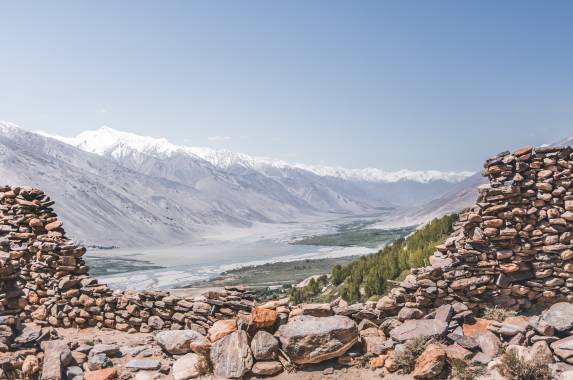
We start the day with a visit to the lovingly decorated Muborakkadam Wakhoni musuem. Wakhoni was a Sufi educator, astronomer and musician. We see a stone solar calendar in Yamg. Next, we drive back to Yamchun to visit an impressive mountain fortress giving us views across the Wakhan and its fertile gardens, fields and villages. We visit the thermal baths of Bibi Fatima and marvel at a Buddhist stupa in Vrang, plus observe numerous cliff caves once inhabited by Buddhist monks.
In Zong, we can climb the imposing ruins of Abreshim Qala fortress and gain views of the Pamir and Wakhan rivers merging to form the Panj, which we’ve followed over much of the previous days. We spend the night in Langar.
We drive for around four hours today with stops, covering around 40mi (70km) with a maximum altitude of 2,880m. Road conditions today are generally reasonable.
Accommodation: Homestay
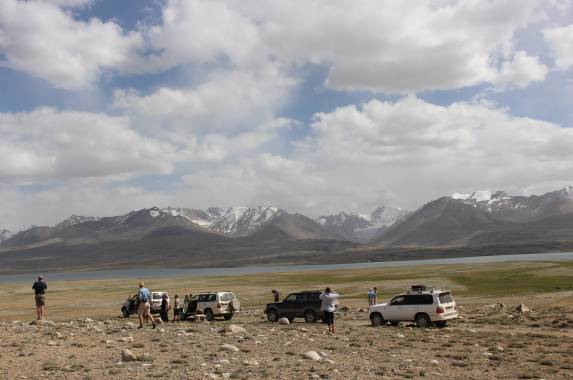
We visit Langar parish hall and an old shrine decorated with ibex and Marco Polo sheep antlers. A walk across flat granite slabs above the village takes us to an area of nearly 6,000 petroglyphs dating from the Bronze Age to the present. A detour takes us to the ruins of Ratm Castle. Heading along the Pamir River, we see a caravanserai on the other side and may see Bactrian camels.
We pause at a military checkpoint then head towards Zorkul Lake (once known to the British as Lake Victoria), the landscape changes and the eastern Pamir plateau comes into view in front of us. The plateau has an average altitude of 13,000ft (4,000m) and the inhabitants call it Bam-i Dunya, the roof of the world. Leaving the (relatively speaking) main road behind us, we head to Jarty Gumbez, known for being home to hot springs, a sun calendar and the tombs of Scythian and Kyrgyz nomads. We may come across herds of Marco Polo sheep, which are giant, wild sheep with horns up to 5ft (160 cm) long. We have time to refresh in the hot springs.
We travel for about six hours today, covering 80mi (130km), reaching our highest sleeping altitude of the trip at 4,110m. We travel off main roads today along rough and bumpy tracks which can be muddy.
Accommodation: Guesthouse
We have an early start and head off with a ranger in search of Marco Polo sheep herds. It may take us a few hours to find them. The sheep are usually seen through binoculars or a telescope. If we’re lucky, we might see ibex too. After returning to the guesthouse, we visit Scythian burial grounds. We now head north, crossing the Ak-Bura Pass at 13,780ft (4,200m). We enter the lunar landscape of Shorbuloq, which has colourful rock formations and a cave with Bronze Age rock paintings at Shakhti. We pass Shorbuloq observatory, once an important Soviet observatory, located here due to the regular dry, cool and stable climate.
In clear weather, we can see mountains in China: Muztag-Ata (24,757ft/7,546m) and Kongur (25,325ft/7,719m). In the late afternoon, we meet the Pamir Highway once again and head to Murghab, the administrative centre of the eastern Pamirs. Murghab was an important military station in the 19th century under the Tsars and later for Soviet Russia. Now the inhabitants are mostly Kyrgyz. There is a small bazaar, mosques and a cemetery, which are worth seeing.
We have about four hours of travel today (80mi/130km), excluding looking for Marco Polo sheep. Our maximum altitude today is 11,875ft (3,620m). The first part of the day is on rough tracks. As we approach Murghab, we rejoin the Pamir Highway and the road conditions improve.
Accommodation: Homestay
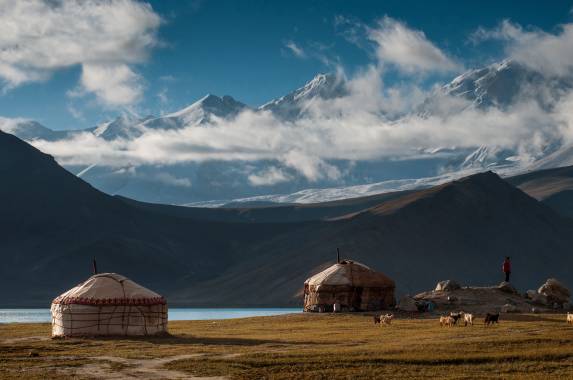
We have a short tour around Murghab, seeing the market and yak house where we can purchase yak-wool handicrafts. Yurts were common in pre-Soviet times, but following construction of permanent houses they are less common.
On our way to Karakul Lake, we reach the highest point of the Pamir Highway and our adventure: Akbaital Pass at 15,272ft (4,655m).
We spend the night in Karakul (meaning Black Lake) at 12,800ft (3,900m) above sea level. The lake itself is 15mi (25km) wide and sits within a crater formed by a meteor impact millions of years ago. This is a cold, remote and hard place to live.
We cover around 85mi (135km) today, taking about three hours, reaching the second highest altitude point in this trip of 13,000ft/3,950m. The road is reasonably good today.
Accommodation: Homestay
We leave Karakul and the Pamir Highway and head southwest into the Bartang Valley. The road is particular rough and travel is very slow but we’re rewarded with a route few tourists take and spectacular mountain scenery. The name Bartang translates approximately as ‘narrow passage’ which is very apt. We stop at Shurali geoglyph and have a picnic lunch along the way.
We stay the night in Ghudara village, partway along the valley. We drive for about five or six hours today with stops on the way, covering around 77mi (125km). Today’s maximum altitude is 3,010m. The road is rough.
Accommodation: Homestay
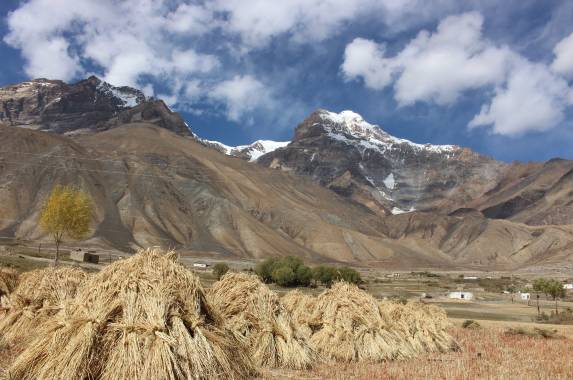
We continue slowly making our way through the Bartang Valley, enjoying the landscapes along the way. We stop at Savnob village to see a 19th-century castle and hear its legends. Inhabitants of the Bartang are among the most hospitable people in the Pamirs. We stay the next two nights in a chid in the village of Yemts with a carved-wood ceiling and square roof window. The interior of chids have symbols linked to the Ismaili faith.
We travel for about six hours today (85mi/135km), with a maximum altitude of 2,060m. The road is rough.
Accommodation: Homestay

We hike in one of the side valleys of Bartang today. You may remain in Yemts on your own if you don’t wish to do the hike. We start by crossing a long bridge over a river and can see tiny terraces, small orchards and fields. Barberry and buckthorn bushes line the narrow path that villagers from Jizew use to reach Bartang. The river is dammed by landslips in places forming small lakes. We have a picnic lunch along the way.
Ascent: 1,640ft (500m); descent: 1,640ft (500m); walking distance: 8.5mi (14km); walking time: approximately six hours, with a maximum altitude of 2,060m. The road is rough.
Accommodation: Homestay
We visit an old mazar this morning, a shrine where Zoroastrianism and Ismailism mix. Shortly after leaving Yemts, we exit the Bartang and are back on the Pamir Highway and return to Kalai Khumb. Along the way, we pass white-sand dunes by the river. On the Afghan side, we see the network of tiny paths across steep rock walls, which used to be the only connections between villages. We stop for lunch (not included) and may have the chance to try local honey.
On arrival in Kalai Khumb, we have a welcome night in a hotel for the first time in several days.
We cover around 150mi (240km) today over about eight hours (including stops), with a maximum altitude of 1,270m. The road is poor today.
Accommodation: Karon hotel (or similar)
This morning, we return to Dushanbe over the Saghir Dasht Pass (10,670ft/3,252m), a different route to the one we took on our outward journey. As we leave the high mountains of the Pamirs behind, the view changes completely. We have a break in Tavildara, where we can see the colourful rocks of Navruz Mountain. We pass orchards and villages and the landscape is increasingly green as we travel through the wide valleys of Vakhsh and Obikhingou.
There are about eight hours of travel today, covering 210mi (340km).
Accommodation: Atlas Hotel (or similar)
The trip ends today in Dushanbe. We begin our return journey home. Alternatively, if you’d like to explore a little more, speak to your sales representative about extending your stay.
We fly back from Dushanbe to London in the early hours of this morning.
Altitude Warning: This trip includes one or more nights over 9,845ft (3,000m) above sea level, where there is a genuine risk of being affected by acute altitude illnesses; if left untreated, this can be life-threatening. Most should expect to experience some mild symptoms of altitude sickness, such as headaches, shortness of breath or sleeplessness. Our leaders are trained to identify symptoms of severe altitude illnesses and, if a customer requires extra care, arrangements such as a rapid descent will be made.
Exodus itineraries are informed by the Wilderness Medical Society (WMS) Guidelines for the Prevention of Altitude Illnesses and designed to allow for adequate acclimatisation. Due to terrain and/or logistical factors, there may be nights where the sleeping altitude gain is more than 1,640ft (500m), increasing the risk. The WMS highlight that because the rates of acclimatisation and physiologic responses to high altitude vary considerably between individuals, the recommendations given, although generally effective, do not guarantee successful prevention. Participants should be aware of the inherent risk posed by altitude.
Several medical conditions or medications can affect a person’s ability to acclimatise, making them more susceptible to acute altitude illnesses. Those with pre-existing conditions, such as heart or lung conditions, those who have suffered with altitude sickness before, or those with concerns about overall physical ability, should consult their doctor before booking. The drug Diamox (acetazolamide) may aid acclimatisation in some individuals. Those considering using Diamox should speak to their doctor about the drug, its suitability, side-effects, and a prescription. Please note, while we endeavour to assist all our customers in achieving their goals, there may be times when a leader decides to delay or stop someone’s ascent based on their condition.
If you are not taking out the Exodus Travel Insurance policy from our partner Campbell Irvine, please make sure your policy covers you up to the maximum altitude on this trip (if trekking in the Himalayas, your policy should also cover the use of a helicopter for emergency medical evacuation).
If you are not taking out Exodus Travel Insurance, make sure your policy covers you up to the maximum altitude on this trip (if trekking in the Himalaya your policy should also cover the use of a helicopter for emergency medical evacuation).
Accommodation
Homestays, guest houses and hotels
Most of the accommodation on this trip is in homestays and guesthouses. The remaining four nights are in hotels. Most homestays and guesthouse are very basic (see Essential Information for more detail) but are the only option in many places and are the best way to gain an insight into life in this region and meet local people. Some homestays have the option of sleeping on a tapchan (a large platform/bed) outside.

Some homestays are in traditional Pamiri houses called chids. These have philosophical and religious significance. The main room is divided into a few sections, such as a cooking and sleeping area, a place to study or keep clothes, and has only one window called a ravzana. The ceiling symbolises four elements of the universe: fire, earth, air and water.


Dinner in a homestay usually consists of two courses: a bowl of soup and a main dish with sides, homemade bread and jam. Usually, it is noodles or rice soup with or without meat, stewed or fried potatoes, plov, and fried vegetables with beef. Expect jam, sweets, biscuits and jurgot, a local Greek yoghurt made from yak or cow milk. For breakfast, a traditional meal is shirchoy, a mixture of milk, butter and salt boiled with black tea leaves. Pieces of bread and a little pepper can be added.
In Dushanbe, we stay in a four-star hotel (local rating). We pass through Kalai Khumb twice. On our outbound journey, we use a homestay, on the return journey we stay in a three-star (local rating) hotel, which will be welcome after several nights in homestays. In Khorog, we stay in a pleasant local-style hotel. In Murghab, we stay in a very modest hotel.
Atlas Hotel Dushanbe:
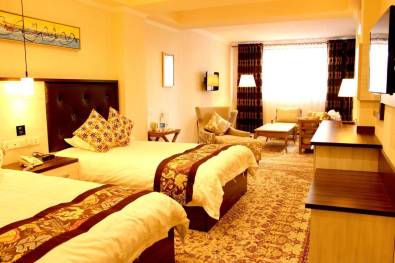
Karon Hotel, Kalai Khumb:
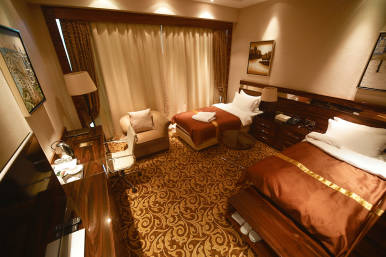
Lal Inn, Khorog:

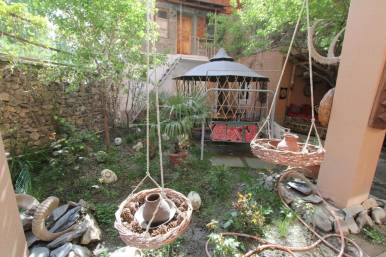
Jarty Gumbez guesthouse:
This guesthouse has its own hot springs, great for relaxing after a long drive.
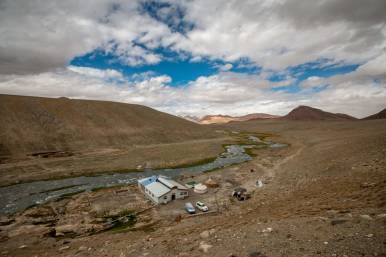
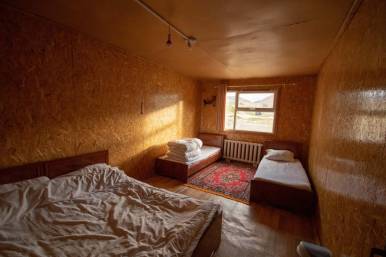
Worth knowing
- The single supplement only applies to Dushanbe, Khorog and the second stay in Kalai Khumb.
Single supplement from USD 472
Food & Drink
When travelling in Tajikistan, be prepared for the meat-heavy cuisine of Central Asia. Over the centuries, it was influenced by various cultures, mainly Persian, Afghan and Russian. Beef and lamb are most commonly eaten. In the Pamirs, you might get to try yak meat in homestays. Different types of beans, grains, meat and vegetables are used. In general, the higher altitude and more remote the accommodation, the more basic the food. There is usually just one option at homestays and guesthouses. Food tends to be quite high in fat.
Non (a flatbread) is served first with meals. The centrepiece and national dish in Tajikistan and Central Asia is plov. The main ingredients are meat, oil, rice, shredded carrots, chickpeas, garlic and sometimes raisins.
The general meal during the trip is plov, qurutob (vegetarian), manti (steamed meat or pumpkin dumplings), different soups, sambusa (puff pastry with meat), laghman (noodle soup with meat), rice, french fries, shish kabab, fresh salads and fruits.
During picnic lunches, on the first days, apples, pears, watermelon, tomato and cucumber, cheese, sausages and salads will be served, followed by jam, honey, instant or espresso coffee, tea, dried fruits, candies, herbal tea, honey, cookies and bread. Dinners include a first and second course followed by various types of cooked salads, tea, dried fruits, biscuits, sweets, jam and honey.
Vegetarians and vegans can be catered for if we are aware before travel, though there will be limited choice. Other dietary requirements are likely to be difficult to accommodate on this trip. Please ask us.
Transport
For the majority of the trip, we travel in fairly modern 4x4s (such as Toyota Land Cruisers) with three people plus a driver in each vehicle. This allows for a reasonable amount of space for each person. On most days, there are several hours of travel, often on very rough and bumpy roads. This trip is not recommended for people who suffer from travel sickness or back problems. In the interest of fairness, you should be prepared to alternate seating positions in the vehicle and not expect to always sit in the front. In and around Dushanbe, we may travel by minibus.
Weather & Seasonality
The climate of Tajikistan is continental, with hot summers and cold winters, but it fluctuates depending on the elevations of the regions and seasonality. Summers in the mountains can be warm, and winters very cold with heavy snowfalls. The lowest recorded temperature was -63C (-81F) in Bulunkul Lake in the Pamirs. The temperature in summer can get as high as 50C (122F) in the Khatlon region. Around 280 days of the year, the sky is clear, sunny and blue.
The climate in the Pamirs (where this trip spends most of the time) is extreme continental: very dry and harsh. The average daytime temperature from May to September is 20C-25C (68F-77F); at night, the temperature can drop to freezing point or below. After a long sunny day, you can have light snowfall. In Dushanbe at this time, the average temperature can be 25C-40C (77F-104F).
Joining Instructions
Key information
Start hotel: Hotel Atlas, 32-24 Nisor Mukhammad Street, Dushanbe, Tajikistan 734124
Phone: +992 44 625-18-18 or +992 44 625-28-28
Recommended arrival time at the start hotel: Early morning on the arrival day for a tour of Dushanbe starting at 10.30am
Airport: Dushanbe Airport (DYU)
Flights
Dushanbe is served by only a limited number of airlines and most do not operate daily. We recommend allowing several hours for connections/changing planes on your way to Tajikistan as a missed connection may delay your arrival by more than a day.
Getting to the start hotel
The start hotel is approximately 10 minutes’ drive from the airport. There’s a group arrival transfer from Dushanbe Airport (DYU) for customers who Exodus booked onto a chosen flight from London, UK. Please speak to your sales representative if you wish to join. If the group departure transfer does not suit your flight time, speak to your sales representative to arrange an alternative transfer at additional cost.
Catching your return flight
There’s a group departure transfer to Dushanbe Airport (DYU) for customers who Exodus booked onto a chosen flight to London, UK. Please speak to your sales representative if you wish to join. If the group departure transfer does not suit your flight time, speak to your sales representative to arrange an alternative transfer at additional cost.
All arrival and departure transfers should be booked with your sales representative at least two weeks before the tour starts.
Full joining instructions including local emergency numbers will be sent to you as part of our Final Joining Instructions. If you do not receive these at least a week before departure, or require them earlier please contact our office or your travel agent.
Location start: Dushanbe
Location end: Dushanbe
What To Take
Essential Equipment
Luggage is best transported in a tough, soft bag (rather than a rigid suitcase) which can withstand some rough treatment.
Items you will need include:
- Comfortable walking shoes
- Comfortable trousers (pants)
- Wind and waterproof jacket/trousers (pants)
- Mix of long and short shirts/T-shirts
- Jacket (eg fleece, softshell, light down)
- Light sweater for evenings and cool mornings in the Pamirs
- Swimwear
- Scarf/buff to protect against dust or cold
- Warm hat
- Sunhat/cap
- Warm gloves
- Sunglasses
- Sunscreen
- Lip balm
- Towel for use in homestays and guesthouses
- Water bottle
- Insect repellent
- Detergent (biodegradable), shampoo, soap
- Head torch (headlamp) with spare batteries
- Small first-aid kit, including any medication you need
- Water purifying tablets (for use in emergency)
Optional Equipment
- Sandals (for use in accommodation, showers etc)
- Shorts
- Binoculars
- Walking poles (for two short walks and longer day walk)
Practical Information
Passport
Remember to check the expiration date of your passport if travelling internationally. Many countries require your passport to be valid for at least six months after the date of your scheduled return.
Visa
Some nationalities require a visa, others do not. UK passport holders require a visa. Most nationalities that need a visa can complete an online Tajikistan e-visa application: https://www.evisa.tj. The e-visa with GBAO permit (see below) costs around US$50. Processing time varies and sometimes requests are made for extra documentation*. We recommend applying for your visa at least one month before your date of travel.
If you do not need a visa, you have to register locally with the authorities. We do this for you; it costs approximately US$35 and is payable locally.
This trip travels through the Gorno-Badakhshan Autonomous region and all nationalities require a GBAO permit. This can be applied for at the same time as the e-visa (which we suggest those who require a Tajik visa should opt for this). For those who do not require a visa, or who do not apply for the permit at the same time as the visa, we can arrange a GBAO permit for you on request at extra cost, at least two weeks before the start of the trip. It will then be received on arrival in Tajikistan.
There is no need to enter a Group Identifier on the e-visa application.
We need copies of your passports, visas and permits at least two weeks before the start of the trip.
*Letter of invitation – a Letter of Invitation (LOI) is in theory no longer required for most applicants, however since early 2024, the Tajik authorities have often requested letters of invitation during e-visa applications. You may receive a message from the Ministry of Foreign Affairs a few days after making your application requesting a letter. If so, please contact us and we can provide one (without charge).
Vaccinations and Health
Tajikistan
There are no required vaccinations. However, you may want to consider vaccinations for polio, tetanus, hepatitis A, hepatitis B, rabies, tuberculosis and typhoid. Please confirm with your doctor or travel clinic.
Local Time
Tajikistan's time zone: Asia/Dushanbe (UTC +05:00)
Electricity
Tajikistan's electricity: Plug types C (two round pins) and F (two round pins) – 220V, 50Hz

Money
Tajikistan's currency: Tajikistani somoni (TJS)
ATM Availability
We recommend taking cash: US dollars in perfect condition, mostly in small denominations (notes larger than US$50 should be avoided). Dollars can be exchanged in banks and exchange offices. All payments should be made in local currency.
ATMs are available in Dushanbe and Khorog; however, it is best not to rely on them. Visa and Mastercard are the most commonly accepted cards. Larger hotels and shops in Dushanbe may accept cards. Elsewhere, do not expect cards to be accepted.
Extra Expenses & Spending Money
The amount of spending money required can vary depending on how much you spend on drinks and souvenirs; as an indication, we recommend you allow around US$100 for non-included meals and possible purchases of souvenirs. This doesn’t include tipping. As a rough guideline, you should allow approximately US$15-US$20) per meal. A coffee in a cafe costs around $2-3, a local beer around $2, a bottle of wine $15+.
Tipping
Tipping is not compulsory but is much appreciated. Should you wish to tip, we suggest the following amounts:
- Leader: 110-165 somoni (US$10-US$15) per day, per group
- Drivers: 90-130 somoni (US$8-US$12) per day, per group
Sustainability and Impact
As a certified B Corp, we’re on a mission to improve our social and environmental impact across all our adventures.
We do this through our innovative Thriving Nature, Thriving People plan.
This ‘nature positive’ approach is designed to help nature and communities thrive in harmony through practical solutions, such as reducing carbon and waste on our trips, supporting conservation projects through the Exodus Adventure Travels Foundation, and rewilding 100 square metres for every Exodus traveller.
Important Information
Insurance – are you adequately covered?
It is a condition of joining any of our trips that you must be fully insured against medical and personal accident risks (to include repatriation costs and air ambulance or helicopter rescue services where appropriate). On arrival in destination for your trip, you will be asked to present details to your leader or local representative of your policy.
If you are resident in the UK, we strongly recommend the Exodus travel insurance policy, this is specifically designed to cover all activities on your trip. If arranging your own policy, please ensure you are covered for all activities that are part of the trip, optional activities that you intend to take part in and/or on high-altitude itineraries, that you are covered up to the maximum altitude of the trip.
This trip goes near an area deemed unsafe to visit by the UK government’s Foreign, Commonwealth and Development Office, whose advice we follow when operating our trips. While our itinerary doesn’t go to these areas, you should familiarise yourself with your local government’s advice if you are planning any pre- or post-trip travel. Any independent travel to areas currently against your local government advice is entirely at your own risk and unlikely to be covered by your travel insurance.
Important Information
Your Safe Participation
When booking this trip, you should be confident in your ability to participate in all activities described in these Trip Notes. If you have any doubt about your suitability, please call us and ask to speak to one of the experts on this itinerary.
Although our leaders are well trained to deal with different capabilities, if they have any concerns about someone’s ability to safely take part in an activity, or their impact on other people’s enjoyment, we authorise them to take necessary action which, in some circumstances, may involve asking someone to miss that activity.
By booking this trip you agree to our Booking Conditions which clearly state that our leaders have the authority to do this. In these rare instances we will ensure anyone sitting out is safely provided for and offered alternative options where possible. Refunds will not be provided for activities missed and customers may be liable for additional costs incurred.
Seatbelts
All vehicles used by us should be equipped with working seatbelts, except where approved by us based on the vehicle type or journey. Wherever seatbelts are available, we require our customers to use them for their own safety, even where it may not be a legal requirement.
Travel Safety
For additional information please have a look at the travel safety advice page on our website.
How to Book
Speak to our friendly team of experts to plan your adventure:
- Check availability: our website shows real-time availability of our guided group tours, or contact our team by phone, email or live chat.
- Hold a space: You can provisionally hold a space on any guided group tour to give you time to finalise your travel plans.
- Confirm your booking: Payment of a deposit will complete your booking and secure your place on the trip.
After booking
You will receive a confirmation document and invoice, which includes extra information and guidance about your travel arrangements. Our dedicated Customer Operations team will help you with any pre-travel questions or arrangements and can easily add extensions or extra accommodation to your booking. Final Joining Instructions will usually be sent out two to three weeks prior to departure.
Adding transfers to your booking
If you have arranged your own flights and would like to add transfers to your booking, please provide your arrival and departure details to our Customer Operations team around four to six weeks before departure.
- Where free transfers are included, they are available for any flight but can only be added to your booking once we have received your flight schedule.
- Where group arrival and departure transfers are available, these operate at fixed times. You will need to arrive in time to meet the scheduled transfer. If the timings don’t align with your travel plans, our team can arrange private transfers once they receive your flight schedule.
Trip Note validity
Trip notes may be updated after booking; if any updates significantly impact the inclusions or itinerary you will be advised in writing. A link to the most up-to-date Trip Notes will be sent out with your Final Joining Instructions before departure.
The information in these Trip Notes is given in good faith. All holidays can be subject to unexpected changes, and occasionally it may not be possible to follow the itinerary as planned. In these circumstances we will make the best-possible alternative arrangements that maintain the integrity of the original itinerary.

